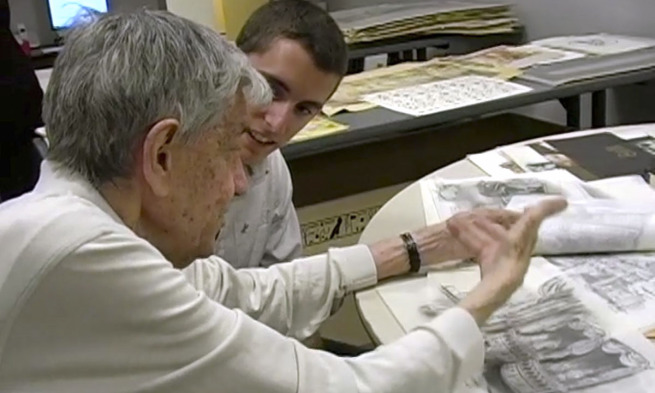How a table, a "Kate" and a "Charles" changed one student's life
Being the Change
A chance meeting. A casual conversation. And an offer he couldn’t refuse. When art and art history major Josh Smead (’12) signed on as an intern for the Madison Art Collection, he didn’t know what he was getting into. Now he does — and is exceedingly grateful for the opportunity of a lifetime.
The job was to help pay his tuition. As a student employee in JMU’s Festival Conference and Student Center, Josh Smead (’12) had delivered a banquet table to Kathryn “Kate” Stevens (’96, ’99M), director of the Madison Art Collection. The art and art history student and the professor struck up a conversation. “Would you be interested in an internship?” she asked.
Their conversation occurred around the time that JMU received an important new art collection. In 2010, JMU alumna Gladys Kemp Lisanby (’49) and her husband James orchestrated the acquisition of the life’s work of Charles Alvin Lisanby, James Lisanby’s brother.
It was a significant acquisition. While Lisanby’s name might not be as familiar as Jackson Pollock or Andy Warhol, the influence of his art is far-reaching — and more familiar than one might think. Lisanby, the only production designer ever inducted into the Academy of Television Arts and Sciences, is a giant in the history of television arts.
Accepting the internship, then-sophomore Smead jumped into Lisanby’s interesting life. Smead became curator of the new collection.
Intersecting television history
Lisanby’s legacy, Smead would realize quickly, was staggering in breadth and depth. The now-retired production designer’s career, which spanned 1948 to 1998, intersected with the most important events in the history of the television industry. Lisanby’s art and work in the burgeoning television industry had merged to create a life of highly influential artistry.
The chance to dig into the collection, to curate a major collection for the university, and to undertake groundbreaking research was a not-to-miss opportunity for the art and art history major. Smead’s job would go far beyond clerical cataloguing and note-taking.
“She (Dr. Stevens) lets me run free with it,” Smead says.
The internship took Smead to New York and Los Angeles where he and Stevens — under the guidance of the retired Lisanby — boxed up more than a half-century of documents, correspondence, drawings, photographs, paintings, art objects, film reels and sketchbooks from Lisanby’s life.
Returning to JMU with the massive collection, Smead began unpacking boxes, sorting and tagging the pieces that as a whole illuminate the history of television. By sifting, studying and organizing the collection, Smead learned Lisanby’s life detail by detail, all enhanced by the invaluable opportunity to discuss it with Lisanby himself.
Close friend and protégé Andy Warhol
One exciting find is a drawing by pop artist Andy Warhol. Warhol, Smead learned, was a close friend and protégé of Lisanby. Warhol and Lisanby worked together, traveled together and, Josh believes, Lisanby’s influence on the life and work of Warhol is substantial.
The collection also includes 260 8mm films, which Smead converted to digital form.
“What’s so exciting about some of the films,” Smead says, “is that you can look at Mr. Lisanby’s original designs for a set and at the same time watch the original performance.”
Comparing the genesis and the “final cut” of a complex production design is one aspect of the collection Smead hopes to exploit through an iPad application that he and two other undergraduate students are developing.
Developing an iPad app specifically for museums
Physics major Matt Burton (’12) and engineering major Peter Epley (’12), both museum interns also, have worked with Smead to develop an iPad application for the museum being named in honor of Gladys Kemp ('49) and retired Rear Admiral James Lisanby and the Charles Lisanby collection. Their app is the first and only iPad app designed specifically for museums. With the “virtual gallery app,” visitors can use the iPad to explore more of an exhibit, including “the ability to zoom in and see the fine details,” Smead says.
“The intersection between technology and art is non-existent,” Smead says. Although he’s gotten some push back from art purists, he answers the criticism two ways: the world is becoming virtual and the app will make art more accessible to more people. And further, the new iPad app will create a permanent archive of the Lisanby collection.
Smead’s experience has been rich and life changing — and common on JMU’s campus where undergraduate students often find themselves with opportunities ordinarily reserved for graduate students and junior faculty members at other colleges and universities.
Signature, hands-on learning
Like Smead, MAC interns John Kimbriel (’13), Frances Loyer (’12) and Emily Meyers (’12) are spending a semester or longer researching an exhibit, creating the text and designing a show they’ll help install. They will also lecture about their research. It is the kind of signature, hands-on learning that prepares JMU students so well.
“Working for Dr. Stevens,” Smead says, “has been the most rewarding and fulfilling portion of my undergraduate experience at James Madison. Her forward thinking guidance has allowed me to have real-world museum experience to prepare me for the next step in my career.”
Smead plans to attend graduate school. His Madison Experience with the Lisanby Collection has established a path that he says he can’t help but pursue.
